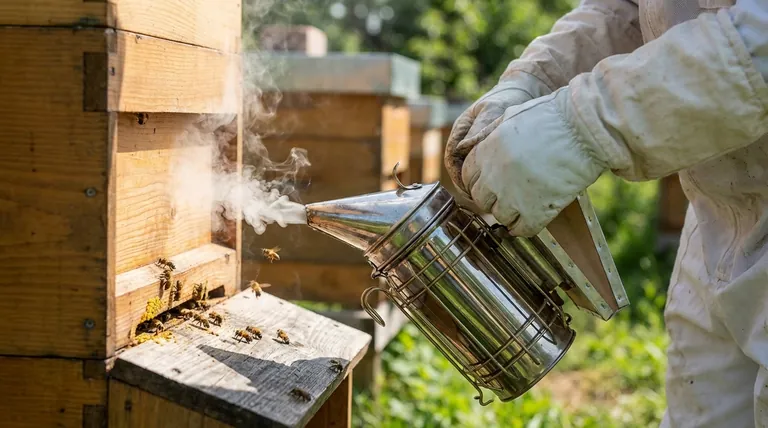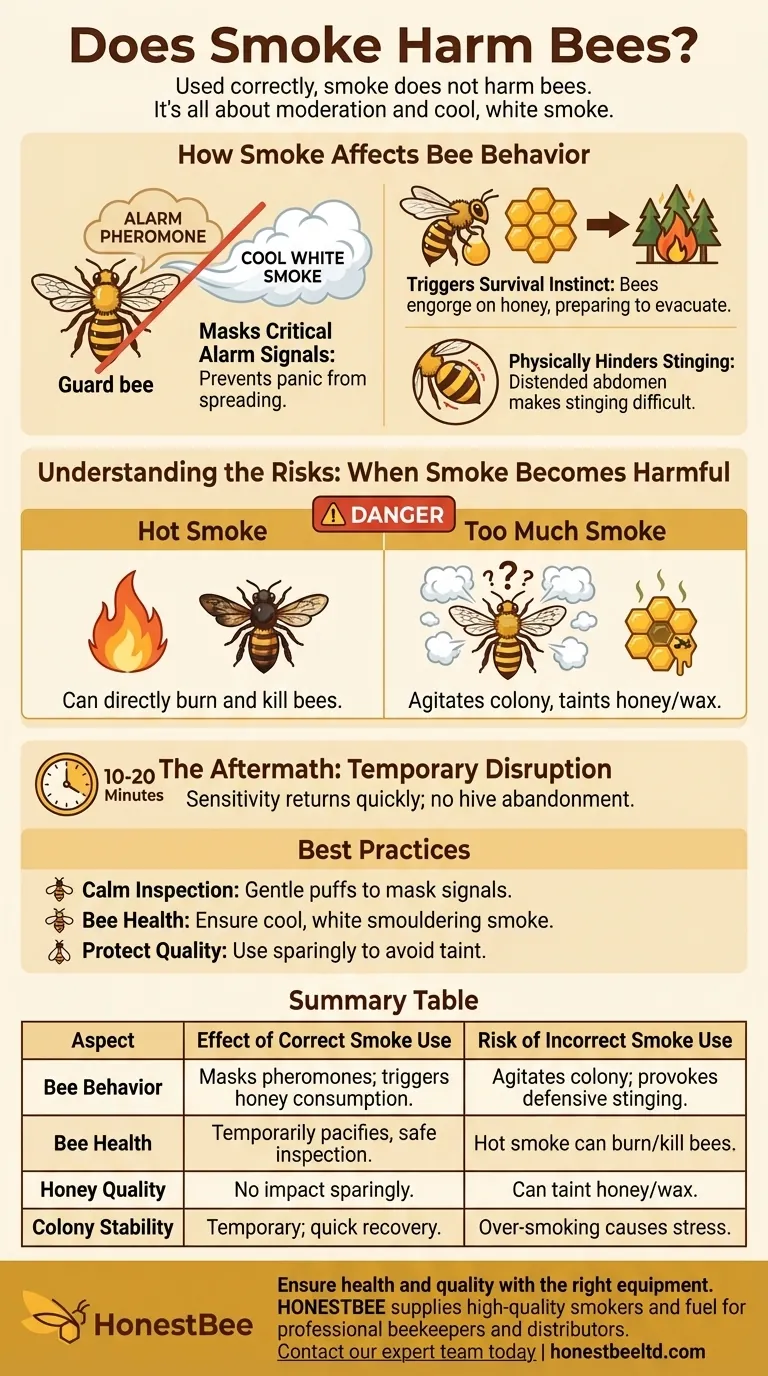Used correctly, smoke does not harm bees. The entire practice hinges on applying cool, white smoke in moderation. This technique interrupts the bees' natural defensive communication and triggers a survival instinct, making the colony manageable for inspection. However, excessive or hot smoke can cause harm, agitate the colony, and even taint the honey.
The core principle is counterintuitive: smoke effectively simulates a threat (fire) to prevent the bees from reacting to a different threat (the beekeeper). This controlled disruption is temporary and far less harmful to the bee than the act of stinging.

How Smoke Actually Affects Bee Behavior
To use smoke effectively, it's essential to understand the specific chain of reactions it triggers within a honeybee colony. It's not a simple sedative; it's a manipulation of their instincts and communication channels.
It Masks Critical Alarm Signals
Guard bees release an alarm pheromone when they perceive a threat. This chemical signal instantly puts the entire colony on high alert and coordinates a defensive, aggressive response.
Smoke works primarily by masking these pheromones. The particles in the smoke interfere with the bees' ability to smell the alarm, preventing panic from spreading throughout the hive.
It Triggers a Survival Instinct
Bees instinctively associate smoke with a forest fire, a major threat to their home. This triggers a specific survival behavior.
They immediately begin to engorge themselves on honey, loading up on energy reserves in case they need to abandon the hive and find a new location.
It Physically Hinders Stinging
A bee's abdomen must be flexible for it to effectively angle its body and deploy its stinger.
When a bee's honey stomach is full, its abdomen becomes distended and heavy. This makes it physically difficult for the bee to sting, serving as a natural pacifier during hive inspections.
Understanding the Risks: When Smoke Becomes Harmful
While proper smoking is safe, improper technique can be detrimental to the colony's health and productivity. The line between a helpful tool and a harmful stressor is defined by temperature and quantity.
The Danger of Hot Smoke
The smoke used on bees must be cool and white. This is achieved by letting the fuel in the smoker smoulder properly rather than burn with an active flame.
Hot smoke can directly burn and kill bees, causing significant damage to the colony.
The Problem with Too Much Smoke
More is not better. Applying too much smoke can override the calming effect and instead confuse and agitate the colony.
Instead of masking pheromones, an overwhelming amount of smoke acts as a severe irritant, which can provoke the very defensive behavior you are trying to avoid.
The Impact on Honey Quality
Beeswax is porous and can absorb aromas from its environment.
If a hive is over-smoked, the wax and honey can become tainted with a smoky flavor, reducing the quality of the final product.
The Aftermath: Do Bees Recover?
The effects of smoke are designed to be a temporary intervention, not a permanent change to the colony's state.
A Temporary Disruption
The bees' sensitivity to alarm pheromones typically returns within 10 to 20 minutes after the smoke has dissipated. The colony quickly reverts to its normal state of communication.
No Hive Abandonment
Despite triggering a "prepare to evacuate" instinct, the brief exposure from a beekeeper's smoker does not cause the colony to abandon the hive. They settle down shortly after the beekeeper leaves.
Best Practices for Safe and Effective Smoking
Your goal determines how you should apply smoke. Understanding the specific purpose behind each puff ensures you are helping, not harming, your bees.
- If your primary focus is a calm inspection: Apply a few gentle puffs at the hive entrance and under the lid to mask initial alarm signals before the bees even see you.
- If your primary focus is bee health: Always ensure your smoker is producing cool, white smoke by letting the fuel smoulder, which prevents any risk of physically burning your bees.
- If your primary focus is protecting honey quality: Use smoke sparingly and only when necessary to avoid tainting the beeswax and the flavor of your honey.
By understanding these principles, beekeepers can use smoke as a tool for safe interaction, ensuring the health of the colony and the quality of their work.
Summary Table:
| Aspect | Effect of Correct Smoke Use | Risk of Incorrect Smoke Use |
|---|---|---|
| Bee Behavior | Masks alarm pheromones; triggers honey consumption. | Agitates colony; provokes defensive stinging. |
| Bee Health | Temporarily pacifies, allowing safe inspection. | Hot smoke can burn and kill bees. |
| Honey Quality | No impact when used sparingly. | Can taint honey and beeswax with smoky flavor. |
| Colony Stability | Effects are temporary; colony recovers quickly. | Over-smoking can cause stress and confusion. |
Ensure the health of your colonies and the quality of your honey with the right equipment.
At HONESTBEE, we supply commercial apiaries and beekeeping equipment distributors with high-quality, reliable smokers and fuel designed for precise, cool smoke generation. Our wholesale-focused operations ensure you get the professional tools you need to manage your hives effectively and safely.
Contact our expert team today to discuss your beekeeping supply needs and optimize your hive management practices.
Visual Guide

Related Products
- Stainless Steel Honey Bee Smoker Hive and Honeycomb Smoker for Beekeeping
- Premium Traditional Copper Bee Smoker with Bellows
- Economy Galvanized Beekeeping Honey Bee Smoker for Wholesale
- European Stainless Steel Bee Smoker for Honey Bee Hive
- Electric Bee Smoker European Style Bee Hive Smoker for Beekeeping
People Also Ask
- How long does it take to clean a bee smoker? From 15-Minute Quick Fix to 10-Hour Deep Clean
- What is the primary purpose of using smoke in beekeeping? Calm Bees for Safer Hive Management
- What is the proper technique for lighting a bee smoker? Master the Layered Fire Method for Calm Hives
- What is a bee smoker and how does it work? Master the Tool for Calm, Safe Hive Inspections
- How did early beekeepers use bee smokers? Master Ancient Bee Calming Techniques



















